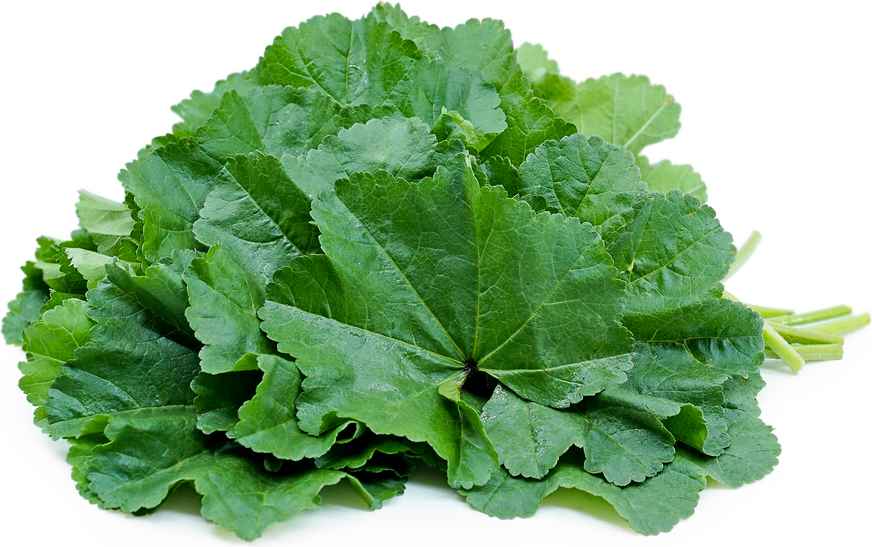


Foraged Mallow (Cheeseweed)
Estimated Inventory, lb : 0
Description/Taste
Cheeseweed is a variant of the mallow herb. It’s about the size of a rosemary sprig, measuring 3 to 12 millimeters in length and 3 to 8 millimeters in width. Cheeseweed is characterized by its green, heart-shaped leaves adorned with lobed ears, shallow-toothed edges, and a red dot at the base of each leaf. The leaves' soft, velvety texture is attributed to tiny, star-shaped hairs present on both its upper and lower surfaces. Cheeseweed's long, slender stems are also enveloped in fine hairs, giving them a slightly rough yet pliable texture. These stems may exhibit a sticky feel due to mucilage, a gelatinous substance commonly produced by plants in this family. Cheeseweed blooms edible flowers throughout the year, displaying hues ranging from white to light pink and lavender, which are noticeably softer and smoother than its leaves and stems. While its mild, earthy aroma is not particularly strong, it becomes more pronounced when the leaves are crushed, releasing the plant's natural oils and compounds. Cheeseweed has a mildly green flavor similar to chard.
Seasons/Availability
Cheeseweed is available in late winter and early spring.
Current Facts
Cheeseweed, botanically known as Malva parviflora, is also called Little mallow and Egyptian mallow. It’s classified as a broadleaf plant and a member of the Malvaceae family, along with cotton, okra, and hibiscus. Its name comes from the seed containing fruit, which resembles a small wheel of cheese segmented into wedges. Historically, Cheeseweed has been viewed as a common plant, often seen as a weed or food source during times of famine. Over time, the species has become notably present in the Middle East and is eaten in various raw or cooked culinary preparations. Cheeseweed not only has culinary uses but a vast variety of medicinal purposes. The plant also yields cream, yellow, and green dyes from both its leaves and seed heads.
Nutritional Value
Cheeseweed is rich in vitamins A, B, and C, which are vital for maintaining healthy vision, a strong immune system, vibrant skin, balanced stress levels, and effective tissue repair. It's also a good source of calcium, magnesium, and potassium, essential minerals that support blood clotting, muscle contractions, and stable blood pressure. The antioxidants, protein, and soluble fibers found in Cheeseweed may contribute to tissue building and repair, blood sugar regulation, and cholesterol reduction. It has been used to improve respiratory function and relieve mild respiratory conditions. Cheeseweed’s analgesic properties make it beneficial for alleviating pain associated with skin and mucous membrane irritation. This same mucilage supports skin care, relieves skin irritations, and enhances oral health when used as a mouthwash to soothe oral tissues. Cheeseweed also serves as a gentle laxative and can aid in treating urinary tract conditions owing to its anti-inflammatory and diuretic properties. A decoction made from its roots or leaves can be used as a hair rinse, offering a natural remedy for dandruff and imparting softness to the hair.
Applications
The entire Cheeseweed plant is edible, including its stems, seeds, and roots. Its leaves can be enjoyed both raw and cooked. Cheeseweed can replace greens in a variety of dishes, whether cooked or raw. You can add fresh leaves to salads, wraps, and salad rolls. Due to its naturally mucilaginous properties, Cheeseweed leaves act as a thickener in soups, stews, and curries. Blanching its leaves can reduce their fuzzy texture, making them more palatable for rice dishes, omelets, veggie burgers, or as a stewing green. In Greece and Turkey, Cheeseweed leaves are often substituted for grape leaves in dolmas, while in Morocco, they're simmered with other greens to create a flavorful herb jam served with bread. Cheeseweed pairs well with spinach, kale, garlic, onions, carrots, potatoes, lentils, beans, rice, goat cheese, feta, chicken, fish, nuts, and seeds. When stored in a perforated container in the refrigerator, fresh Cheeseweed can remain fresh for up to a week.
Ethnic/Cultural Info
During the War of Independence in Jerusalem, people heavily depended on edible plants from the Malva family, likely including Cheeseweed. Amidst the siege of Jerusalem, when food convoys could not reach the city, residents ventured into the fields to gather these leaves, transforming them into a variety of dishes to sustain themselves. In the Middle East, the term "khubeza" refers to the Malva species and holds significant cultural importance in some regions, particularly during times of scarcity, where it has served as a crucial food source.
Geography/History
Native to Eurasia and Northern Africa, the foraging of Cheeseweed for food dates back to 6000 BCE. It has long been a food source in the Middle East and today is still popularly used for culinary purposes in Egypt, Greece, Turkey, Italy, Israel, and Syria. Cheeseweed was introduced to the United States by Europeans in the 1800s, though it has yet to take off in the culinary scene and is thought of mostly as an agricultural weed. Cheeseweed can commonly be found growing in vineyards, gardens, orchards, urban sites, roadsides, and disturbed land plots. It can thrive in most conditions, given that it has optimal soil. When Cheeseweed is grown in nitrogen-rich soil, it may absorb excessive nitrates, potentially reaching levels toxic to cattle, horses, sheep, and poultry. Therefore, caution is advised when cultivating Cheeseweed near farm animals. When in season, Cheeseweed is sold through growers at fresh local markets and foraged from wild plants.
Recipe Ideas
Recipes that include Foraged Mallow (Cheeseweed). One
| Cook for Your Life |
|
Wild Salad |
| Tasty Craze |
|
Mallow Tea |
| Gourmandelle |
|
Spring Ricotta Tart with Edible Weeds |




